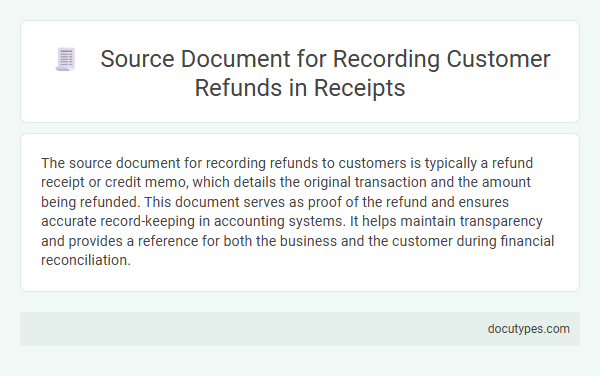The source document for recording refunds to customers is typically a refund receipt or credit memo, which details the original transaction and the amount being refunded. This document serves as proof of the refund and ensures accurate record-keeping in accounting systems. It helps maintain transparency and provides a reference for both the business and the customer during financial reconciliation.
Introduction to Source Documents for Customer Refunds
Source documents serve as the initial record for financial transactions, providing essential details for accounting purposes. When recording refunds to customers, these documents ensure accuracy and transparency in the refund process.
Common source documents for customer refunds include credit memos, return receipts, and refund vouchers. These documents detail the transaction specifics, such as the amount refunded, date, and customer information, forming the basis for journal entries.
Importance of Accurate Refund Documentation
The source document for recording refunds to customers is typically the refund receipt or credit memo issued by your business. Accurate refund documentation is essential to maintain clear financial records, ensure transparency, and support audit processes. Properly recorded refunds help prevent discrepancies in accounting and protect your business from potential disputes.
Types of Source Documents Used for Refunds
The source document for recording refunds to customers is essential for accurate financial tracking and accountability. Various types of source documents are utilized to validate and process these refund transactions efficiently.
- Refund Receipt - A document issued to customers confirming the return of funds for goods or services.
- Credit Note - A formal statement provided by the seller indicating a reduction in the amount owed by the customer due to a refund.
- Return Authorization Form - A document that approves the return of products and initiates the refund process with detailed transaction information.
Essential Information in a Refund Receipt
The source document for recording refunds to customers is the refund receipt. This document serves as official proof of the transaction and records the details of the returned goods or services.
A refund receipt includes essential information such as the date of the refund, the amount refunded, and the reason for the refund. It also contains the customer's name and contact details along with the original purchase information. Accurate recording of this data helps maintain proper financial records and improves customer service tracking.
Workflow for Documenting Customer Refunds
The source document for recording refunds to customers is typically the customer refund receipt or credit memo. This document provides official proof of the transaction and details the refund amount, date, and reason.
The workflow for documenting customer refunds begins with authorization from the finance or sales department. Next, the refund receipt is issued, recorded in the accounting system, and linked to the original sales invoice for accurate tracking and reconciliation.
Role of Receipts in Refund Transactions
The source document for recording refunds to customers is the receipt originally issued during the sale. Receipts serve as proof of purchase, detailing the transaction date, items bought, and payment method, which helps verify refund eligibility. In refund transactions, receipts provide essential data for accurate record-keeping and financial reconciliation.
Compliance and Audit Requirements for Refund Documentation
What is the source document for recording refunds to customers? The primary source document for refund transactions is the refund receipt or credit memo, which provides detailed information about the return and refund process. Accurate retention of these documents ensures compliance with auditing standards and supports transparency during financial reviews.
Common Mistakes in Recording Refund Receipts
The source document for recording refunds to customers is typically the refund receipt or credit memo issued during the transaction. Accurate recording ensures proper accounting and customer relationship management.
Common mistakes in recording refund receipts can lead to financial discrepancies and reporting errors.
- Using Incorrect Documentation - Recording refunds without a valid refund receipt or credit memo can cause audit issues and inaccurate financial records.
- Failing to Match Refunds with Original Sales - Overlooking the link between refund receipts and original sales invoices complicates reconciliation and tracking returns.
- Ignoring Proper Timing - Recording refunds on incorrect dates affects financial statement accuracy and cash flow analysis.
Best Practices for Managing Refund Source Documents
The source document for recording refunds to customers is typically a refund receipt or credit memo issued by the company. Proper management of these documents ensures accurate financial records and customer transaction tracking.
- Maintain organized records - Store refund receipts and credit memos systematically for easy retrieval during audits.
- Verify documentation accuracy - Ensure refund amounts and customer details are correctly recorded to prevent discrepancies.
- Implement approval workflows - Require managerial approval on refund documents to reduce fraud risks and maintain accountability.
Applying these best practices enhances transparency and improves the integrity of refund transactions in accounting systems.
What Is the Source Document for Recording Refunds to Customers? Infographic

